Alexandria, Egypt › Trade in the Roman World › Ancient origins
Articles and Definitions › Contents
- Alexandria, Egypt › Ancient History
- Trade in the Roman World › Antique Origins
Ancient civilizations › Historical and archaeological sites
Alexandria, Egypt › Ancient History
Definition and Origins
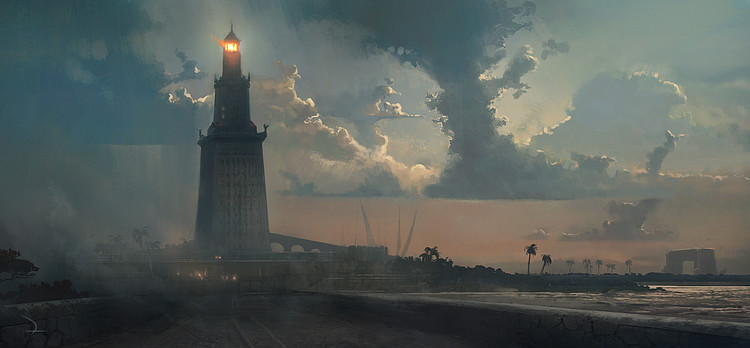
Alexandria is a port city located on the Mediterranean Sea in northern Egypt founded in 331 BCE by Alexander the Great.It is most famous in antiquity as the site of the Pharos, the great lighthouse, considered one of the seven wonders of the ancient world, for the Temple of Serapis, the Serapion, which was part of the legendary library at Alexandria, as a seat of learning and, once, the largest and most prosperous city in the world. It also became infamous for the religious strife which resulted in the martyrdom of the philosopher Hypatia of Alexandria in 415 CE. The city grew from a small port town to become the grandest and most important metropolis in ancient Egypt.
FOUNDATION BY ALEXANDER
After conquering Syria in 332 BCE, Alexander the Great swept down into Egypt with his army. He founded Alexandria in the small port town of Rhakotis by the sea and set about the task of turning it into a great capital. It is said that he designed the plan for the city which was so greatly admired later by the historian Strabo (63 BCE-21CE) who wrote,
The city has magnificent public precincts and royal palaces which cover a fourth or even a third of the entire area. For just as each of the kings would, from a love of splendour, add some ornament to the public monuments, so he would provide himself at his own expense with a residence in addition to those already standing.
ALEXANDRIA ATTRACTED SCHOLARS, SCIENTISTS, PHILOSOPHERS, MATHEMATICIANS, ARTISTS, & HISTORIANS.
The palaces and grand homes Strabo mentions did not exist at the time Alexander founded the city. Although he was greatly admired by the Egyptians (and was even declared a demi-god by the Oracle at Siwa), Alexander left Egypt only a few months after his arrival to march on Tyre in Phoenicia. It was left to his commander, Cleomenes, to build the city Alexander had envisioned. While Cleomenes accomplished a great deal, the full expansion of Alexandria came under the rule of Alexander's general Ptolemy and the rule of the Ptolemaic Dynasty (332-30 BCE) which followed. After Alexander's death in 323 BCE, Ptolemy brought his body back to Alexandria to be entombed and, following the wars of the Diodachi, began rule of Egypt from Alexandria, supplanting the old capital of Memphis. Tyre had been an important city for trade and commerce in the region and, after its destruction by Alexander, Alexandria filled the void which had been left. Carthage (which largely became so prosperous owing to the sack of Tyre) was still a young port town when Alexandria began to thrive. The historian and scholar Mangasarian writes,
“Under the Ptolemies, a line of Greek kings, Alexandria soon sprang into eminence, and, accumulating culture and wealth, became the most powerful metropolis of the Orient. Serving as the port of Europe, it attracted the lucrative trade of India and Arabia. Its markets were enriched with the gorgeous silks and fabrics from the bazaars of the Orient. Wealth brought leisure, and it, in turn, the arts. It became, in time, the home of a wonderful library and schools of philosophy, representing all the phases and the most delicate shades of thought. At one time it was the general belief that the mantle of Athens had fallen upon the shoulders of Alexandria.

Gold Octadrachm of Ptolemy II & Arsinöe II
The city grew to become the largest in the known world at the time, attracting scholars, scientists, philosophers, mathematicians, artists, and historians. Eratosthenes (c.276-194 BCE) calculated the circumference of the earth to within 50 miles (80 km) at Alexandria. Euclid taught at the university there. Archimedes (287-212 BCE) the great mathematician and astronomer may have taught there and was certainly studied there. The greatest engineer and mathematician of his day, Hero (also known as Heron, 10-70 CE) was born and lived in Alexandria. Hero was credited with amazing feats in engineering and technology including the first vending machine, the force-pump, and a theatre of automated figures who danced, among his other inventions.
THE LIBRARY OF ALEXANDRIA WAS COMPLETED BY PTOLEMY II (285-246 BCE) WHO SENT INVITATIONS TO RULERS AND SCHOLARS ASKING THEM TO CONTRIBUTE BOOKS.
THE LIBRARY OF ALEXANDRIA
The library, begun under Ptolemy I (305-285 BCE) was completed by Ptolemy II (285-246 BCE) who sent invitations to rulers and scholars asking them to contribute books. According to historians Oakes and Gahlin, “There was room for up to 70,000 papyrus scrolls. Most of the items were bought but other means were sometimes used. In order to procure coveted works, all ships entering the harbour were searched. Every book found was taken to the Library where it was decided whether to give it back or confiscate it and replace it with a copy” (230). No one knows how many books were held in the library at Alexandria but estimates have been made of 500,000. It is said that Mark Antony gave Cleopatra 200,000 books for the library but this claim has been disputed since antiquity. Mangasarian writes,
After its magnificent library, whose shelves supported a freight more precious than beaten gold, perhaps the most stupendous edifice in the town was the temple of Serapis. It is said that the builders of the famous temple of Edessa boasted that they had succeeded in creating something which future generations would compare with the temple of Serapis in Alexandria. This ought to suggest an idea of the vastness and beauty of the Alexandrian Serapis, and the high esteem in which it was held. Historians and connoisseurs claim it was one of the grandest monuments of Pagan civilization, second only to the temple of Jupiter in Rome, and the inimitable Parthenonin Athens. The Serapis temple was built upon an artificial hill, the ascent to which was by a hundred steps. It was not one building, but a vast body of buildings, all grouped about a central one of vaster dimensions, rising on pillars of huge magnitude and graceful proportions. Some critics have advanced the idea that the builders of this masterpiece intended to make it a composite structure, combining the diverse elements of Egyptian and Greek art into a harmonious whole. The Serapion was regarded by the ancients as marking the reconciliation between the architects of the pyramids and the creators of the Athenian Acropolis. It represented to their minds the blending of the massive in Egyptian art with the grace and the loveliness of the Hellenic.
When Carthage rose to the height of her power, Alexandria was relatively unaffected as trade had long been established and the city posed no threat to the sea power of the Carthaginians. Even after the fall of Carthage following the Punic Wars (264-146 BCE), when Rome became supreme and Alexandria fell under her sway, the city remained prosperous and continued to attract visitors from all over the world. The increasing tensions in Rome between Julius Caesar and Pompey first impacted Alexandria negatively in 48 BCE. Prior to this date, though the city certainly experienced its share of problems, it remained a stable environment. Following the Battle of Pharsalus, however, at which Caesar defeated Pompey, Pompey fled to Alexandria seeking sanctuary and was killed by the co-regent Ptolemy XIII. Caesar arrived and, whether real or feigned, claimed outrage at the death of his former friend and ally. He then declared martial law, took over the royal palace, and sent for the exiled co-regent Cleopatra VII. In the civil war which ensued much of Alexandria was burned including, according to some scholars, the famous library.
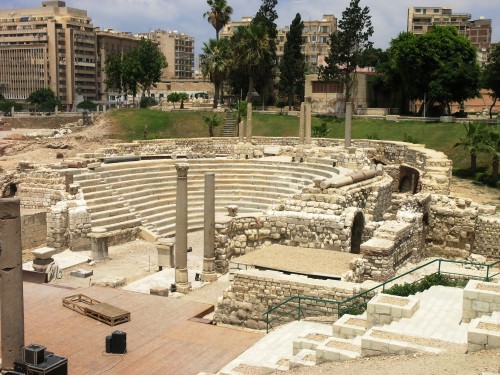
Roman Theatre, Alexandria
ROMAN ALEXANDRIA
Following Caesar's assassination in 44 BCE, his right-hand man, Marcus Antonius (Mark Antony ) became Cleopatra's consort and left Rome for Alexandria. The city became his base of operations over the next thirteen years until he and Cleopatra were defeated by Octavian Caesar at the Battle of Actium in 31 BCE. The next year, Cleopatra and Antony both committed suicide and, with her death, the Ptolemaic line came to an end. Octavian became first emperor of Rome and took the title ` Augustus '. Alexandria now became a simple province of the Roman Empire under the rule of Augustus Caesar.
Augustus consolidated his power in the provinces and had Alexandria restored. Scholars who argue against Julius Caesar's role in the burning of the great library point to the fact that there is evidence it was still extant under the reign of Augustus and that visitors were still attracted to the city as a seat of learning. Alexandria was again ruined in 115 CE in the Kitos War and was again restored, this time by the Emperor Hadrian, who, as a man of learning, took great interest in Alexandria. According to tradition, the Greek Septuagint (the Greek translation of the Bible ) was composed in Alexandria, completed in 132 CE, in order that it could take its place among the great books of the library in the city. Religious scholars were said to frequent the library for research and Alexandria had long attracted people of many different faiths who vied for dominance in the city. Under Augustus' reign there were disputes between Jews and pagans and, as Christianity grew in popularity, the Christians added to the public unrest. After the Roman emperor Constantine the Great (272-337 CE) passed the Edict of Milan in 313 CE (decreeing religious tolerance), Christians were no longer liable for prosecution under the law and began to not only demand more religious rights, but more vociferously attack the pagans and the Jews.
CHRISTIANITY & THE DECLINE OF ALEXANDRIA
Alexandria, which had been a city of prosperity and learning, became an arena of religious contention between the new faith of the Christians and the old faith of the pagan majority. The Christians increasingly felt bold enough to strike at the symbols of the old faith in an attempt to topple it. Magasarian writes,
It is not so much religion that makes the character of a people, as it is the people who determine the character of their religion. Religion is only the resume of the national ideas, thoughts, and character. Religion is nothing but an expression. It is not, for instance, the word or the language which creates the idea, but the idea which provokes the word into existence. In the same way religion is only the expression of a people's mentality. And yet a man's religion or philosophy, while it is but the product of his own mind, exerts a reflex influence upon his character. The child influences the parent, of whom it is the offspring; language affects thought, of which, originally, it was but the tool. So it is with religion. The Christian religion, as soon as it got into power, turned the world about.
Perhaps nowhere more than in Alexandria was this turn-about more apparent. Under the reign of Theodosius I (347-395 CE) paganism was outlawed and Christianity encouraged. In 391 CE the Christian Patriarch Theophilus followed Theodosius' lead and had all the pagan temples in Alexandria destroyed or converted into churches. By the year 400 CE Alexandria was in constant religious turmoil and, in 415 CE, this resulted in the murder of the Neo-Platonic philosopher Hypatia and, according to some scholars, the burning of the great library and the complete destruction of the temple of Serapis. Alexandria declined rapidly after this date with scholars, scientists, and thinkers of all disciplines leaving the city for safer locales.
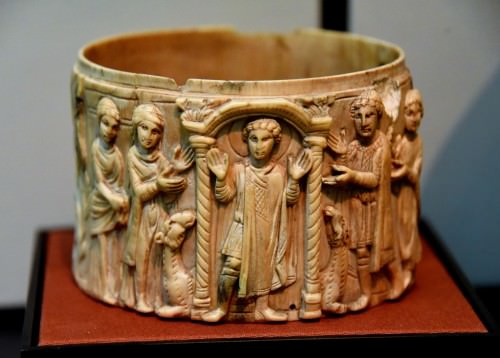
Ivory Pyxis Depicting Saint Menas
The city became steadily impoverished after the rise of Christianity, both financially and culturally, and became increasingly a battlefield for warring faiths. It was conquered by the Sassanid Persians in 619 CE. The Christian Byzantine Empire under Heraclius re-claimed the city in 628 CE but lost it to the invading Arab Muslims under Caliph Umar in 641 CE. The forces of the Christian Byzantines and the Muslim Arabs then fought for control of the city, and Egypt, until the Arabian forces prevailed in 646 CE and Egypt fell under Islamic rule. The churches were now destroyed or transformed in mosques and Christian legend claims that it was at this time that the great library was burned by the Muslim conquerors.
What was not destroyed by war was taken down by nature and, by 1323 CE, most of Ptolemaic Alexandria was gone. The great lighthouse was steadily destroyed by earthquakes as was much of the port. In 1994 CE the first discoveries were made known of a number of relics, statuary, and buildings in the harbor of Alexandria. These have been steadily excavated by Professor Jean-Yves Empereur and his team who continue to bring to light the lost golden age of Alexandria.
MAP
Trade in the Roman World › Antique Origins
Ancient Civilizations
Regional, inter-regional and international trade was a common feature of the Roman world. A mix of state control and a free market approach ensured goods produced in one location could be exported far and wide. Cereals, wine and olive oil, in particular, were exported in huge quantities whilst in the other direction came significant imports of precious metals, marble, and spices.
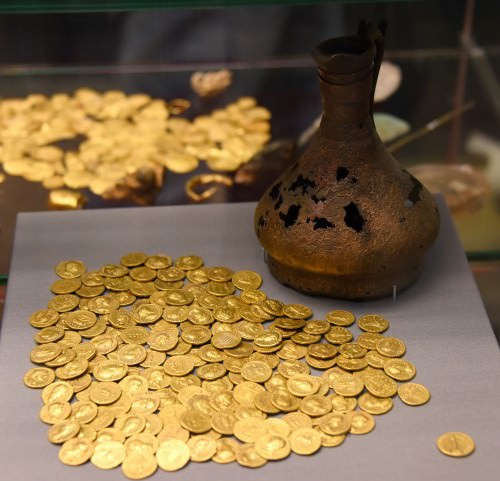
Corbridge Hoard & Jug
FACTORS DRIVING TRADE
Generally speaking, as with earlier and contemporary civilizations, the Romans gradually developed a more sophisticated economy following the creation of an agricultural surplus, population movement and urban growth, territorial expansion, technology innovation, taxation, the spread of coinage, and not insignificantly, the need to feed the great city of Rome itself and supply its huge army wherever it might be on campaign.
The economy in the Roman world displayed features of both underdevelopment and high achievement. Elements of the former, some historians have argued (notably MIFinley), are:
- an over-dependence on agriculture
- a slow diffusion of technology
- the high level of local town consumption rather than regional trade
- a low level of investment in industry.
However, there is also evidence that from the 2nd century BCE to the 2nd century CE there was a significant rise in the proportion of workers involved in the production and services industries and greater trade between regions in essential commodities and manufactured goods. In the later empire period, although trade in the east increased - stimulated by the founding of Constantinople - trade in the western empire declined.
THOSE CITIZENS RICH ENOUGH TO INVEST, OFTEN EMPLOYED SLAVES, FREEDMEN, & AGENTS TO MANAGE THEIR BUSINESS AFFAIRS.
The Roman attitude to trade was somewhat negative, at least from the higher classes. Land ownership and agriculture were highly regarded as a source of wealth and status but commerce and manufacturing were seen as a less noble pursuit for the well-off. However, those rich enough to invest often overcame their scruples and employed slaves, freedmen, and agents ( negotiatores ) to manage their business affairs and reap the often vast rewards of commercial activity.
TRADED GOODS
Whilst the archaeological evidence of trade can sometimes be patchy and misrepresentative, a combination of literary sources, coinage and such unique records as shipwrecks helps to create a clearer picture of just what the Romans traded, in what quantity, and where.
Trade involved foodstuffs (eg olives, fish, meat, cereals, salt, prepared foods such as fish sauce, olive oil, wine and beer ), animal products (eg leather and hides), objects made from wood, glass, or metals, textiles, pottery, and materials for manufacturing and construction such as glass, marble, wood, wool, bricks, gold, silver, copper, and tin. Finally, there was, of course, also the substantial trade in slaves.

Roman Mosaic Showing the Transport of an Elephant
The fact that many goods were produced as regional specialities on often very large estates, for example, wine from Egypt or olive oil from southern Spain, only increased the inter-regional trade of goods. That such large estates could produce a massive surplus for trade is evidenced at archaeological sites across the empire: wine producers in southern France with cellars capable of storing 100,000 litres, an olive oil factory in Libya with 17 presses capable of producing 100,000 litres a year, or gold mines in Spain producing 9,000 kilos of gold a year. Although towns were generally centres of consumption rather than production, there were exceptions where workshops could produce impressive quantities of goods. These 'factories' might have been limited to a maximum workforce of 30 but they were often collected together in extensive industrial zones in the larger cities and harbours, and in the case of ceramics, also in rural areas close to essential raw materials (clay and wood for the kilns).
SOMETIMES TRADE GOODS FOLLOWED LAND ROUTES SUCH AS THE WELL-ESTABLISHED SILK ROAD OR TRAVELLED BY SEA ACROSS THE MEDITERRANEAN & INDIAN OCEANS.
Goods were not only exchanged across the Roman world, however, as bustling ports such as Gades, Ostia, Puteoli, Alexandria, and Antioch also imported goods from such far-flung places as Arabia, India, Southeast Asia, and China.Sometimes these goods followed land routes such as the well-established Silk Road or travelled by sea across the Indian Ocean. Such international trade was not necessarily limited to luxury goods such as pepper, spices (eg cloves, ginger, and cinnamon), coloured marble, silk, perfumes, and ivory, though, as the low-quality pottery found in shipwrecks and geographical spread of terracotta oil lamps illustrates.
TRANSPORTING GOODS
Goods were transported across the Roman world but there were limitations caused by a lack of land transport innovation. The Romans are celebrated for their roads but in fact, it remained much cheaper to transport goods by sea rather than by river or land as the cost ratio was approximately 1:5:28. Nevertheless, it should be remembered that sometimes the means of transport was determined by circumstances and not by choice and all three modes of transport grew significantly in the 1st and 2nd centuries CE.
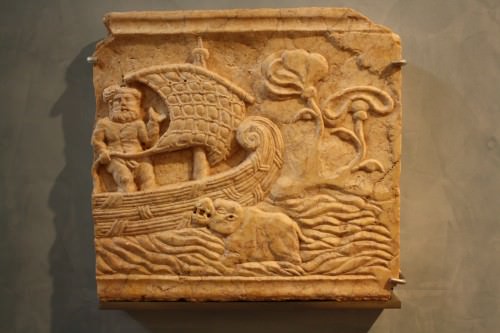
Ship Relief, Saguntum
Although transport by sea was the cheapest and fastest method (1,000 nautical miles in 9 days) it could also be the riskiest - subject to the whims of weather and theft from piracy - and was restricted by the seasons as the period between November and March (at least) was regarded as being too unpredictable for safe passage.
From the analysis of over 900 shipwrecks from the Roman period the most typical size of merchant vessel had a capacity for 75 tons of goods or 1500 amphorae but there were bigger vessels capable of transporting up to 300 tons of goods. One interesting example is the 40s CE Port Vendres II wreck located in the Mediterranean off the Spanish-French border. The cargo was taken from at least 11 different merchants and contained olive oil, sweet wine, fish sauce, fine pottery, glass, and ingots of tin, copper, and lead.
STATE CONTROL OF TRADE
In the imperial period, there was great state control over trade in order to guarantee supply (the annona system) and even a state merchant fleet, replacing the system during the Republic of paying subsidies ( vecturae ) to encourage private shipowners. There was a specific official in charge of the grain supply (the praefectus annonae ) who regulated the various shipowner associations ( collegia navicularii ). The state taxed the movement of goods between provinces and also controlled many local markets ( nundinae ) - often held once a week - as the establishment of a market by a large land-owner had to be approved by the Senate or emperor.
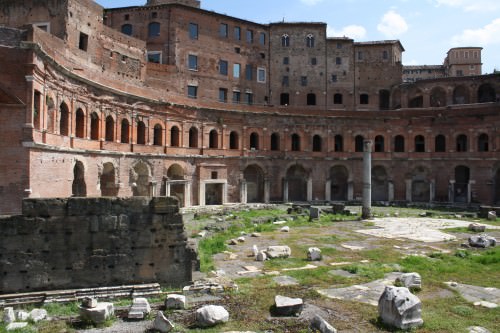
Trajans Market, Rome
The greatest state expenditure was on the army, which required some 70% of the budget. The state's apparatus of taxation to acquire revenue may be considered a success in that, despite the tax burden, local prosperity and economic growth were not unduly hampered.
Evidence of state control can be seen in the many goods which were stamped or carried markers indicating their origin or manufacturer and in some cases guaranteeing their weight, purity or genuineness. Pottery, amphorae, bricks, glass, metal ingots (important for coinage), tiles, marble and wooden barrels were usually stamped and general goods for transportation carried metal tags or lead seals. These measures helped to control trade, provide product guarantees and prevent fraud.Inscriptions on olive oil amphorae were particularly detailed as they indicated the weight of the vessel empty and of the oil added, the place of production, the name of the merchant transporting them and the names and signatures of the officials who carried out these controls.
Trade was also carried out completely independent from the state, though, and was favoured by the development of banking.Although banking and money-lending generally remained a local affair there are records of merchants taking out a loan in one port and paying it off in another once the goods were delivered and sold on. There is also abundant evidence of a free-trade economy beyond the reaches of the empire and independent of the larger cities and army camps.
CONCLUSION
Whatever the exact economic mechanisms and proportion of state to private enterprise, the scale of trade in the Roman world is hugely impressive and no other pre-industrial society came even close. Such mundane functional items as amphorae or oil lamps were produced in their millions and it has been estimated that in Rome alone the quantity of oil traded was 23,000,000 kilograms per year whilst the city's annual wine consumption was well over 1,000,000 hectolitres, probably nearer 2 million.These kinds of figures would not be seen again until industrialisation swept the developed world long after Roman traders had closed their accounting books and been forgotten by history.
LICENSE:
Article based on information obtained from these sources:with permission from the Website Ancient History Encyclopedia
Content is available under License Creative Commons: Attribution-NonCommercial-ShareAlike 3.0 Unported. CC-BY-NC-SA License